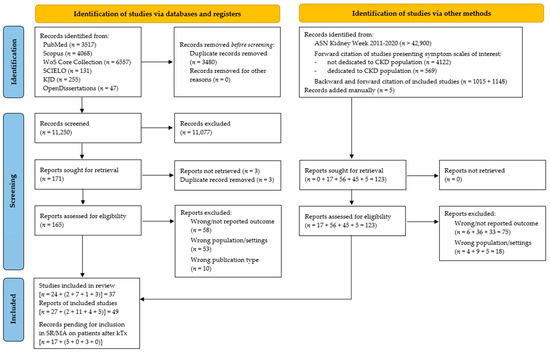J. Clin. Med. 2022, 11(21), 6363; https://doi.org/10.3390/jcm11216363 - 28 Oct 2022
Cited by 6 | Viewed by 3740
Abstract
Chronic kidney disease (CKD) patients experience a wide range of symptoms that deteriorate their health-related quality of life (HRQoL). We aimed to estimate the prevalence and severity of lower gastrointestinal (GI) symptoms in non-dialysis CKD adult outpatients, and to summarize the relationships between
[...] Read more.
Chronic kidney disease (CKD) patients experience a wide range of symptoms that deteriorate their health-related quality of life (HRQoL). We aimed to estimate the prevalence and severity of lower gastrointestinal (GI) symptoms in non-dialysis CKD adult outpatients, and to summarize the relationships between these symptoms and HRQoL, laboratory test results, and clinical data. The protocol of the study was preregistered (PROSPERO CRD42021255122). We searched MEDLINE, Scopus, Web of Science, and grey literature sources from the databases’ inception up until 27 November 2021. Wide citation chasing was conducted. Single proportions (prevalence of functional constipation, self-reported constipation, diarrhea, abdominal bloating, fecal incontinence, and abdominal/rectal pain) were pooled using generalized linear mixed models. A total of 37 studies with 12,074 patients were included. We found that lower GI symptoms, especially self-reported abdominal bloating [CKD G1–2: 48.45% (95% CI: 43.5–53.4%; 2 studies); G3: 46.95% (95% CI: 45.0–48.9%; 2 studies), G4–5: 36.1% (95% CI: 25.4–48.5%; 8 studies)] and constipation [CKD G1–2: 31.8% (95% CI: 13.9–54.9%); G3: 29.8% (95% CI: 21.2–40.1%; 4 studies); G4–5: 38.8% (95% CI: 30.9–47.4%); 22 studies)], were common in non-dialysis CKD patients. The severity of the symptoms was limited. Self-reported constipation was most consistently associated with worse HRQoL, whereas hard stool consistency was associated with higher uremic toxins levels. To conclude, since lower GI symptoms are common in CKD, using symptom questionnaires that do not take them into account cannot provide full insight into the patient’s experience. Further studies are needed to cover identified knowledge gaps, including the exploration of the pathophysiology of GI symptoms in CKD with multi-omics data.
Full article
(This article belongs to the Special Issue Chronic Kidney Disease: Triggering New Paradigms of Treatment and Care)
►
Show Figures











